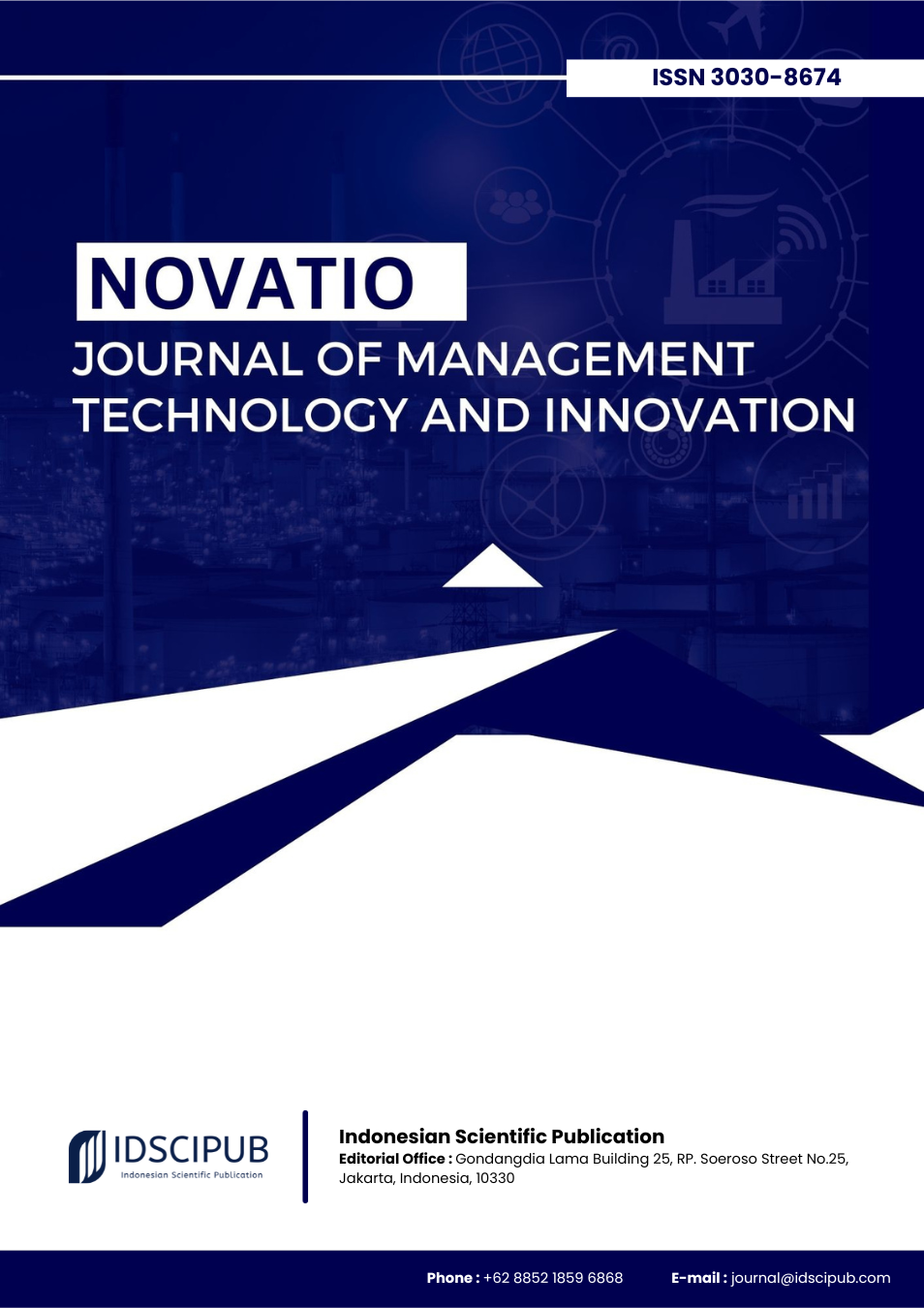Digital Collaboration in Distributed Teams: Innovation, Productivity, and Global Perspectives
DOI:
https://doi.org/10.61978/novatio.v3i1.1006Keywords:
Remote Work, Digital Collaboration Tools, Productivity, Innovation, Emotional Intelligence, Distributed Teams, Organizational CultureAbstract
The shift to remote work following the COVID-19 pandemic has accelerated reliance on digital collaboration tools, fundamentally transforming organizational practices. This study conducts a narrative review to examine how such tools support productivity, communication, and innovation within distributed teams. Literature was systematically gathered from Scopus, Web of Science, and Google Scholar, using targeted keywords and inclusion criteria to capture peer-reviewed research from the past five years. The synthesis integrates quantitative and qualitative evidence across sectors and regions, emphasizing both technological and human dimensions of remote collaboration. Results indicate that platforms such as Microsoft Teams, Slack, and Zoom enhance efficiency and foster innovation, with studies reporting measurable productivity gains in teams adopting these tools. Emotional intelligence and transformational leadership emerge as critical in sustaining team cohesion and mitigating stress in virtual environments. Global comparisons reveal disparities, with advanced economies benefiting from stronger infrastructure and supportive policies, while developing countries face heightened challenges due to limited access and cultural constraints. Discussion highlights systemic factors, including policy frameworks, organizational culture, and digital infrastructure, as determinants of success. The review concludes by recommending policy support for infrastructure development, continuous digital training, and leadership practices grounded in emotional intelligence. These strategies are essential to addressing current limitations and ensuring sustainable remote collaboration. The study identifies opportunities for future research on cross-cultural dynamics, long-term outcomes, and organizational-level innovation.
References
Alsaleh, S., Tepljakov, A., Köse, A., Belikov, J., & Petlenkov, E. (2022). Reimagine lab: bridging the gap between hands-on, virtual and remote control engineering laboratories using digital twins and extended reality. IEEE Access, 10, 89924-89943. https://doi.org/10.1109/access.2022.3199371 DOI: https://doi.org/10.1109/ACCESS.2022.3199371
Asfahani, A. (2025). Navigating digital leadership: unraveling the dynamics of remote work environments. TEM Journal, 823-835. https://doi.org/10.18421/tem141-73 DOI: https://doi.org/10.18421/TEM141-73
Баніт, О., Ростока, М., Raievska, Y., Кравчук, О., & Cherevychnyi, G. (2023). Digital collaboration of virtual project teams in the transdisciplinary educational space., 2928, 090004. https://doi.org/10.1063/5.0172780 DOI: https://doi.org/10.1063/5.0172780
Briciu, V., Briciu, A., & Floroiu, E. (2024). Exploring the work-life balance effects of work from home in the corporate environment in Romania., 343-366. https://doi.org/10.4018/979-8-3693-3470-6.ch016 DOI: https://doi.org/10.4018/979-8-3693-3470-6.ch016
Busboom, J., & Boulus-Rødje, N. (2024). The quest for “how to do hybrid right”: moving beyond compensating asymmetries to experience-driven cooperation. Proceedings of the ACM on Human-Computer Interaction, 8(CSCW2), 1-30. https://doi.org/10.1145/3686983 DOI: https://doi.org/10.1145/3686983
Efimov, I., Rohwer, E., Harth, V., & Mache, S. (2022). Virtual leadership in relation to employees' mental health, job satisfaction and perceptions of isolation: a scoping review. Frontiers in Psychology, 13. https://doi.org/10.3389/fpsyg.2022.960955 DOI: https://doi.org/10.3389/fpsyg.2022.960955
Ghanbaripour, A., Tumpa, R., Skitmore, M., & Hon, C. (2025). Project delivery success and sustainability: comparative strategies in the post-pandemic era. Management Decision. https://doi.org/10.1108/md-03-2024-0445 DOI: https://doi.org/10.1108/MD-03-2024-0445
Gowrishankkar, V., Bhavani, J., Vijay, B., Murugesan, M., Velmurugan, P., & Govindaraju, V. (2024). Agile HRM practices., 27-46. https://doi.org/10.4018/979-8-3693-6274-7.ch002 DOI: https://doi.org/10.4018/979-8-3693-6274-7.ch002
Hassan, M., Strand, J., Strømhaug, A., & Erichsen, L. (2022). 1-click automatic well design using integrated cloud software. https://doi.org/10.2523/iptc-22018-ms DOI: https://doi.org/10.2523/IPTC-22018-MS
Hoque, M., Zhang, X., Rahman, M., Boroumand, Z., & Hasnat, M. (2025). A comprehensive review of enhancing collaboration and performance in virtual teams. Review of Business and Economics Studies, 13(1), 93-108. https://doi.org/10.26794/2308-944x-2025-13-1-93-108 DOI: https://doi.org/10.26794/2308-944X-2025-13-1-93-108
İLHAN, Ü. (2025). Cybersecurity in human resource management in the context of remote work., 145-168. https://doi.org/10.4018/979-8-3693-6417-8.ch007 DOI: https://doi.org/10.4018/979-8-3693-6417-8.ch007
Kanwal, P., Malik, P., Purty, J., Rawat, N., Randhawa, S., & Kaur, K. (2025). Redefining work., 317-340. https://doi.org/10.4018/979-8-3373-1270-5.ch018 DOI: https://doi.org/10.4018/979-8-3373-1270-5.ch018
Kulbayeva, S., Tazhibayeva, K., Seyduanova, L., Smagulova, I., Mussina, A., Tanabayeva, S., … & Saliev, T. (2022). The recent advances of mobile healthcare in cardiology practice. Acta Informatica Medica, 30(3), 236. https://doi.org/10.5455/aim.2022.30.236-250 DOI: https://doi.org/10.5455/aim.2022.30.236-250
Losev, T., Storteboom, S., Carpendale, S., & Knudsen, S. (2020). Distributed synchronous visualization design: challenges and strategies., 1-10. https://doi.org/10.1109/beliv51497.2020.00008 DOI: https://doi.org/10.1109/BELIV51497.2020.00008
Menshikova, M., Bonacci, I., Scarozza, D., & Zifaro, M. (2025). The employee satisfaction with the new normal ways of working: a cluster analysis. Journal of Asia Business Studies, 19(3), 863-892. https://doi.org/10.1108/jabs-08-2024-0474 DOI: https://doi.org/10.1108/JABS-08-2024-0474
Paglialonga, A., Gaetano, R., Robert, L., Hurard, M., Botella, L., Barr, N., … & Pini, A. (2021). Ehealth for patients with rare diseases: the ehealth working group of the European Reference Network on rare multisystemic vascular diseases (vascern). Orphanet Journal of Rare Diseases, 16(1). https://doi.org/10.1186/s13023-020-01604-4 DOI: https://doi.org/10.1186/s13023-020-01604-4
Pawar, S., & Dhumal, V. (2024). The role of technology in transforming leadership management practices. Multidisciplinary Reviews, 7(4), 2024066. https://doi.org/10.31893/multirev.2024066 DOI: https://doi.org/10.31893/multirev.2024066
Pizzagalli, S., Kuts, V., Bondarenko, Y., & Otto, T. (2021). Evaluation of virtual reality interface interaction methods for digital twin industrial robot programming and control, a pilot study. https://doi.org/10.1115/imece2021-69408 DOI: https://doi.org/10.1115/IMECE2021-69408
Rodríguez, I. (2025). Assessing the impact of virtual workplaces on collaboration and learning. Frontiers in Psychology, 16. https://doi.org/10.3389/fpsyg.2025.1581029 DOI: https://doi.org/10.3389/fpsyg.2025.1581029
Schmidtner, M., Doering, C., & Timinger, H. (2021). Agile working during COVID-19 pandemic. IEEE Engineering Management Review, 49(2), 18-32. https://doi.org/10.1109/emr.2021.3069940 DOI: https://doi.org/10.1109/EMR.2021.3069940
Sever, M. (2024). Digital transformation and changes in business models for service industries., 94-116. https://doi.org/10.4018/979-8-3693-2019-8.ch006 DOI: https://doi.org/10.4018/979-8-3693-2019-8.ch006
Suganya, R., Venkateshwaran, G., & Kumar, A. (2024). Navigating the hybrid work revolution., 215-230. https://doi.org/10.4018/979-8-3693-3057-9.ch014 DOI: https://doi.org/10.4018/979-8-3693-3057-9.ch014
Thakur, K., Chand, B., & Dhand, S. (2023). Developments in the remote work and learning., 189-214. https://doi.org/10.4018/978-1-6684-9522-3.ch012 DOI: https://doi.org/10.4018/978-1-6684-9522-3.ch012
Weaver, J., Matney, G., Goedde, A., Nadler, J., & Patterson, N. (2021). Digital tools to promote remote lesson study. International Journal for Lesson and Learning Studies, 10(2), 187-201. https://doi.org/10.1108/ijlls-09-2020-0072 DOI: https://doi.org/10.1108/IJLLS-09-2020-0072
Xue, T., & Lan, Q. (2025). Optimization of the online collaboration platform: an event queue management algorithm based on debounce and throttle techniques., 16. https://doi.org/10.1117/12.3055726 DOI: https://doi.org/10.1117/12.3055726
Zacharaki, E., Triantafyllidis, A., Carretón, R., Loeck, M., Michalellis, I., Michalakis, G., … & Tzovaras, D. (2022). A user evaluation study of augmented and virtual reality tools for training and knowledge transfer., 291-304. https://doi.org/10.1007/978-3-031-05039-8_21 DOI: https://doi.org/10.1007/978-3-031-05039-8_21





